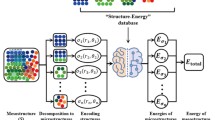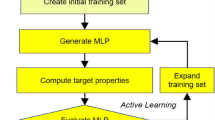Abstract
Recently, the machine learning (ML) atomic force field has emerged as a powerful atomic simulation approach because of its high accuracy, low computational cost, and transferability. In this mini review, we first summarize the disadvantages of traditional force field and the unique advantages of ML-based force field for molecular dynamics simulations. Then the basic workflow to develop the ML atomic force field is discussed in each step. Furthermore, taking carbon material as a typical example, the various applications of ML-based force fields for studying the carbon allotropic materials are reviewed. Finally, the perspectives are discussed and future directions for studying atomic force field by ML are given.
Access this chapter
Tax calculation will be finalised at checkout
Purchases are for personal use only
Similar content being viewed by others
References
Tang, Y., Zhang, D., et al. (2018). An atomistic fingerprint algorithm for learning ab initio molecular force field. The Journal of Chemical Physics, 148, 034101.
Berman, D., Sanket, A., Erdemire, A., et al. (2015). Macroscale superlubricity enabled by grapheme anoscroll formation. Science, 14, 126202.
Behler, J. (2017). First principles neural network potentials for reactive simulations of large molecular and condensed systems. Angewandte Chemie, 56, 12828–12840.
Botu, V., Batra, R., Chapman, J., et al. (2016). Machine learning force fields: construction, validation, and outlook. The Journal of Physical Chemistry C, 121, 511–522.
Botu, V., & Ramprasad, R. (2015). Adaptive machine learning framework to accelerate ab initio molecular dynamics. International Journal of Quantum Chemistry, 115, 1074–1083.
Botu, V., & Ramprasad, R. (2015). Learning scheme to predict atomic forces and accelerate materials simulations. Physical Review B, 92, 094306.
Chan, H., Narayanan, B., Cherukara, M. J., et al. (2019). Machine learning classical interatomic potentials for molecular dynamics from first-principles training data. The Journal of Physical Chemistry C, 123, 6941–6957.
Elliott, J. A. (2013). Novel approaches to multiscale modelling in materials science. International Materials Reviews, 56, 207–225.
Erdemir, A., Ramirez, G., Eryilmaz, O. L., et al. (2016). Carbon-based tribofilms from lubricating oils. Nature, 536, 67–71.
Gomez-Bombarelli, R., Aguilera-Iparraguirre, J., Hirzel, T. D., et al. (2016). Design of efficient molecular organic light-emitting diodes by a high-throughput virtual screening and experimental approach. Nature Materials, 15, 1120–1127.
Hautier, G., Jain, A., & Ong, S. P. (2012). From the computer to the laboratory: materials discovery and design using first-principles calculations. Journal of Materials Science, 47, 7317–7340.
Huan, T. D., Batra, R., Chapman, J., et al. (2017). A universal strategy for the creation of machine learning-based atomistic force fields. npj Computational Materials, 3, 37.
Isayev, O., Oses, C., Toher, C., et al. (2017). Universal fragment descriptors for predicting properties of inorganic crystals. Nature Communications, 8, 15679.
Jiang, Z., He, J., Deshmukh, S. A., et al. (2015). Subnanometre ligand-shell asymmetry leads to Janus-like nanoparticle membranes. Nature Materials, 14, 912–917.
Ju, S., Shiga, T., Feng, L., et al. (2017). Designing nanostructures for phonon transport via Bayesian optimization. Physical Review X, 7, 021024.
Neugebauer, J., & Hickel, T. (2013). Density functional theory in materials science. Wiley interdisciplinary reviews. Computational Molecular Science, 3, 438–448.
Smith, J. S., Nebgen, B. T., Zubatyuk, R., et al. (2019). Approaching coupled cluster accuracy with a general-purpose neural network potential through transfer learning. Nature Communications, 10, 2903.
Li, Z., Kermode, J. R., & De Vita, A. (2015). Molecular dynamics with on-the-fly machine learning of quantum-mechanical forces. Physical Review Letters, 114, 096405.
Botu, V., Chapman, J., & Ramprasad, R. (2017). A study of adatom ripening on an Al (1 1 1) surface with machine learning force fields. Computational Materials Science, 129, 332–335.
Kruglov, I., Sergeev, O., Yanilkin, A., et al. (2017). Energy-free machine learning force field for aluminum. Scientific Reports, 7, 8512.
Suzuki, T., Tamura, R., & Miyazaki, T. (2017). Machine learning for atomic forces in a crystalline solid: transferability to various temperatures. International Journal of Quantum Chemistry, 117, 33–39.
Li, W., & Ando, Y. (2018). Comparison of different machine learning models for the prediction of forces in copper and silicon dioxide. Physical Chemistry Chemical Physics (PCCP), 20, 30006–30020.
Artrith, N., & Behler, J. (2012). High-dimensional neural network potentials for metal surfaces: A prototype study for copper. Physical Review B, 85, 045439.
Artrith, N., & Kolpak, A. M. (2015). Grand canonical molecular dynamics simulations of Cu–Au nanoalloys in thermal equilibrium using reactive ANN potentials. Computational Materials Science, 110, 20–28.
Artrith, N., & Urban, A. (2016). An implementation of artificial neural-network potentials for atomistic materials simulations: performance for TiO2. Computational Materials Science, 114, 135–150.
Behler, J., Martonak, R., Donadio, D., et al. (2008). Metadynamics simulations of the high-pressure phases of silicon employing a high-dimensional neural network potential. Physical Review Letters, 100, 185501.
Eshet, H., Khaliullin, R. Z., Kühne, T. D., et al. (2010). Ab initio quality neural-network potential for sodium. Physical Review B, 81, 184107.
Artrith, N., Morawietz, T., & Behler, J. (2011). High-dimensional neural-network potentials for multicomponent systems: Applications to zinc oxide. Physical Review B, 83, 153101.
Khaliullin, R. Z., Eshet, H., Kühne, T. D., et al. (2010). Graphite-diamond phase coexistence study employing a neural-network mapping of theab initiopotential energy surface. Physical Review B, 81, 100103.
Kondati Natarajan, S., Morawietz, T., & Behler, J. (2015). Representing the potential-energy surface of protonated water clusters by high-dimensional neural network potentials. Physical Chemistry Chemical Physics (PCCP), 17, 8356–8371.
Yao, K., Herr, J. E., Toth, D. W., et al. (2018). The TensorMol-0.1 model chemistry: A neural network augmented with long-range physics. Chemical Science, 9, 2261–2269.
Mi, X. Y., Yu, X., Yao, K. L., et al. (2015). Enhancing the thermoelectric figure of merit by low-dimensional electrical transport in phonon-glass crystals. Nano Letters, 15, 5229–5234.
Seko, A., Togo, A., Hayashi, H., et al. (2015). Prediction of low-thermal-conductivity compounds with first-principles anharmonic lattice-dynamics calculations and bayesian optimization. Physical Review Letters, 115, 205901.
Li, S., Yu, X., Bao, H., et al. (2018). High thermal conductivity of bulk epoxy resin by bottom-up parallel-linking and strain: A molecular dynamics study. The Journal of Physical Chemistry C, 122, 13140–13147.
Song, Q., An, M., Chen, X., et al. (2016). Adjustable thermal resistor by reversibly folding a graphene sheet. Nanoscale, 8, 14943–14949.
Yang, H., Zhang, Z., Zhang, J., et al. (2018). Machine learning and artificial neural network prediction of interfacial thermal resistance between graphene and hexagonal boron nitride. Nanoscale, 10, 19092–19099.
Ma, D., Ding, H., Wang, X., et al. (2017). The unexpected thermal conductivity from graphene disk, carbon nanocone to carbon nanotube. International Journal of Heat and Mass Transfer, 108, 940–944.
Yu, X., Li, R., Shiga, T., et al. (2019). Hybrid thermal transport characteristics of doped organic semiconductor poly(3,4-ethylenedioxythiophene): Tosylate. The Journal of Physical Chemistry C, 123, 26735–26741.
Behler, J. (2011). Atom-centered symmetry functions for constructing high-dimensional neural network potentials. The Journal of Chemical Physics, 134, 074106.
Bartók, A. P., Kondor, R., & Csányi, G. (2017). Erratum: On representing chemical environments. Physical Review B, 96, 019902.
Bartók, A. P., & Csányi, G. (2015). Gaussian approximation potentials: A brief tutorial introduction. International Journal of Quantum Chemistry, 115, 1051–1057.
Zong, H., Pilania, G., Ding, X., et al. (2018). Developing an interatomic potential for martensitic phase transformations in zirconium by machine learning. npj Computational Materials, 4, 48.
Fan, J., Sun, Q., Zhou, W.-X., et al. (2018). Principal component analysis for big data. 1–13.
Rowe, P., Csányi, G., Alfè, D., et al. (2018). Development of a machine learning potential for graphene. Physical Review B, 97, 054303.
Wen, M., & Tadmor, E. B. (2019). Hybrid neural network potential for multilayer graphene. Physical Review B, 100, 195419.
Wen, M., & Tadmor, E. B. (2020). Uncertainty quantification in molecular simulations with dropout neural network potentials. npj Computational Materials, 6, 124.
Deringer, V. L., & Csányi, G. (2017). Machine learning based interatomic potential for amorphous carbon. Physical Review B, 95, 094203.
Rowe, K., Deringer, V. L., & Gasprotto, P. (2020). An accurate and transferable machine learning potential for carbon. Chemical Pysics, 153, 034702.
Khaliullin, R. Z., Eshet, H., Kuhne, T. D., et al. (2011). Nucleation mechanism for the direct graphite-to-diamond phase transition. Nature Materials, 10, 693–697.
Bartok, A. P., Payne, M. C., Kondor, R., et al. (2010). Gaussian approximation potentials: The accuracy of quantum mechanics, without the electrons. Physical Review Letters, 104, 136403.
Behler, J., & Parrinello, M. (2007). Generalized neural-network representation of high-dimensional potential-energy surfaces. Physical Review Letters, 98, 146401.
Khaliullin, R. Z., Eshet, H., Kühne, T. D., et al. (2010). Graphite-diamond phase coexistence study employing a neural-network mapping of theab initiopotential energy surface. Physical Review B, 81, 100103(R).
Deringer, V. L., Merlet, C., Hu, Y., et al. (2018). Towards an atomistic understanding of disordered carbon electrode materials. Chemical Communications, 54, 5988–5991.
Deringer, V. L., Csanyi, G., & Proserpio, D. M. (2017). Extracting crystal chemistry from amorphous carbon structures. Chemphyschem: A European Journal of Chemical Physics and Physical Chemistry, 18, 873–877.
Author information
Authors and Affiliations
Corresponding author
Editor information
Editors and Affiliations
Rights and permissions
Copyright information
© 2021 The Author(s), under exclusive license to Springer Nature Switzerland AG
About this chapter
Cite this chapter
Liu, X., Wang, Q., Zhang, J. (2021). Machine Learning Interatomic Force Fields for Carbon Allotropic Materials. In: Cheng, Y., Wang, T., Zhang, G. (eds) Artificial Intelligence for Materials Science. Springer Series in Materials Science, vol 312. Springer, Cham. https://doi.org/10.1007/978-3-030-68310-8_4
Download citation
DOI: https://doi.org/10.1007/978-3-030-68310-8_4
Published:
Publisher Name: Springer, Cham
Print ISBN: 978-3-030-68309-2
Online ISBN: 978-3-030-68310-8
eBook Packages: Chemistry and Materials ScienceChemistry and Material Science (R0)




